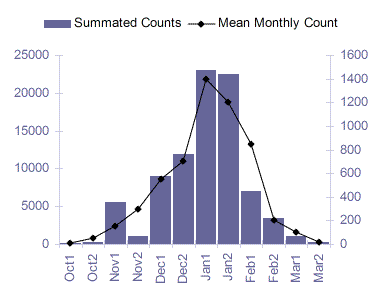[Reprinted with minor editorial changes from British Birds (1987) 80: 632-633]
'Seasonality of Herring Gulls in the West Midlands Region' |
The subspecific composition of Herring Gulls Larus argentatus wintering in central England has been the subject of some debate. In a field study of a winter roost in Staffordshire, Hume (1978) recognised four types of Herring Gull, one of which he considered referable to L. a. argentatus. Subsequently, the feasibility of distinguishing in the field between Scandinavian L. a. argentatus and British L. a. argenteus has been disputed (for example, Morley 1979). Ringing studies in northern Britain (Coulson et al. 1984) and in southeast England (Stanley et al. 1981) have indicated that argentatus arrives on the wintering grounds later in the season than argenteus. British Herring Gulls tend to winter relatively close to their breeding grounds, and there is significant occupation of wintering sites from August onwards (Stanley et al. 1981). At Chew Valley Lake, Avon, for example (where most wintering Herring Gulls are considered to be of relatively local origin), the numbers roosting in late September 1979 were as high as 70% of the eventual December/January maximum (K. E. Vinicombe in litt.). By contrast, significant numbers of Scandinavian argentatus do not arrive in Britain before November, and reach a peak in January; dispersal occurs rapidly in late January and February.
The monthly distribution of numbers at wintering sites is thus potentially significant. Accordingly, I have attempted to determine the seasonality of wintering Herring Gulls in the West Midlands Region, using two methods: (a) a series of almost weekly counts at Blithfield Reservoir, Staffordshire, in the period September to March during the ten winters 1974/75 to 1983/84; (b) summing all dated records included in the annual West Midland Bird Reports for the years 1970 to 1984. The results are presented in figure 1, and show a broad measure of agreement.

Fig. 1. Half-monthly distribution of Herring Gulls Larus argentatus: (a) right-hand scale and line: mean counts at Blithfield Reservoir, Staffordshire, 1974/75-83/84; (b) left-hand scale and blocks: summated counts in the West Midlands Region, 1970-84.
Thus, the characteristics of the winter profile - with numbers increasing from November, reaching a considerable peak in January, and a rapid dispersal during February - are close to those for populations known to include a significant argentatus component.
Herring Gulls have started to breed in the region since Figure 1 was generated in 1987 (but are well outnumbered by breeding Lesser Black-backed Gulls). The numbers of Herring Gulls present during spring, summer and even early autumn have increased correspondingly and some no doubt remain in the region throughout the winter. However, the numbers of breeding individuals are relatively small (in the hundreds) in comparison with the significant, incoming, mid-winter population, which numbers in the thousands. See <here> for discussions and graphics of the changes in monthly profile related to the larger breeding population of Lesser Black-backed Gulls.
Coulson, J. C., Monaghan, P., Butterfield, J. E. L., Duncan, N., Ensor, K., Shedden, C., & Thomas, C. 1984. Scandinavian Herring Gulls wintering in Britain.
Ornis Scand. 15:79-88.
Hume, R. A. 1978. Variations in Herring Gulls at a Midland Roost. Brit. Birds 71: 338-345.
Morley, C. 1979. Variations in Herring Gulls. Brit. Birds 72: 389-390.
Stanley, P. I, Brough, T., Fletcher, M. R., Horton, N., Rochard, J. B. A. 1981. The origins of Herring Gulls wintering inland in south-east England. Bird Study 28: 123-132.
|
|
|
|
Home |
Mediterranean
| Laughing |
Franklin's |
Little |
Sabine's |
Bonaparte's |
Black-headed |
Ring-billed | Common |
Lesser Black-backed | |